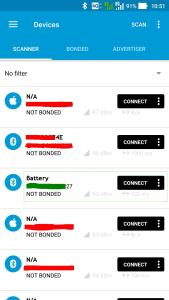This post is about how to do two simple things using Node-Red:
- Check if network service on the machine running Node-Red is available by checking the corresponding listening port.
- The Node-Red UI doesn’t have a status indicator available, so I’ve built one
The only limitation on the following solution is that it only tests for ports for services that are running on the same server, where Node-Red is also running.
Preparation:
We need to install the Is Port Available NPM Module and make it available into our Node-Red instance.
For doing so, in Linux we must do the following:
root@server:~# cd .node-red/ root@server:~/.node-red# npm i --save is-port-available
We need now to make this node module available to Node-Red by editing the settings.js file:
root@server:~/.node-red# vi settings.js
Add the module to the global context on the function named functionGlobalContext:
functionGlobalContext: {
// os:require('os'),
// octalbonescript:require('octalbonescript'),
// jfive:require("johnny-five"),
// j5board:require("johnny-five").Board({repl:false})
portavail:require('is-port-available')
},
You might have other modules configured, so we need to add the above portavail:require(‘is-port-available’) line to that list preceded by a comma.
We need to restart Node-Red to make the module available to the flows.
The testing flow
In our Function nodes, we can now use the global context object portavail to access the is-port-available module.
For example for testing the InfluxDB server port (1086/TCP) we can write the following function:
// Instantiate locally on the flow the is-port-available module
const isPortAvailable = context.global.portavail;
msg.payload = {}; // Zero out the message. Not really necessary
var port = 1086; // Replace this with your service port number. In this case 1086 is the Influx DB port
isPortAvailable(port).then( status => {
if(status) {
//console.log('Port ' + port + ' IS available!');
msg.payload = {'InfluxDB':false,"title":"InfluxDB","color":"red"}; // The port is available, hence the server is NOT running
node.send(msg);
} else {
//console.log('Port ' + port + ' IS NOT available!');
//console.log('Reason : ' + isPortAvailable.lastError);
msg.payload = {'InfluxDB':true,"title":"InfluxDB","color":"green"}; // The port is not available, so the server MIGHT be running
node.send(msg);
}
});
// Note that we DO NOT return a message here since the above code is asynchronous and it will emit the message in the future.
Since the test is using promises, Node-Red will continue executing without waiting for the test response (the isPortAvailable(port) code ). So we do not send any message further on the normal Node-Red execution flow (hence there is no return msg; object) and the message is only emitted when the promise fulfils. When that happens we just send the message with the node.send(msg) statement.
The message payload can be anything, being the only important properties the title and color that are used for creating the UI status indicator.
The status indicator is a simple Angularjs template that displays the title and a status circle with the chosen colour.
Since pasting CSS and HTML code in WordPress is recipe to disaster, the template code can be accessed on this gist or on the complete test flow below:
[{"id":"1f506795.4be25","type":"inject","z":"53f8b852.885c6","name":"Check todos os 60s","topic":"","payload":"","payloadType":"date","repeat":"60","crontab":"","once":true,"x":260,"y":96,"wires":[["5d180fc7.9ad06","27e67f9b.4f9158"]]},{"id":"5d180fc7.9ad06","type":"function","z":"53f8b852.885c6","name":"Test Influx DB","func":" const isPortAvailable = context.global.portavail;\n msg.payload = {};\n \n var port = 8086;\n \n isPortAvailable(port).then( status =>{\n if(status) {\n //console.log('Port ' + port + ' IS available!');\n msg.payload = {'InfluxDB':false,\"title\":\"InfluxDB\",\"color\":\"red\"}; // The port is available, hence the server is NOT running\n node.send(msg);\n } else {\n //console.log('Port ' + port + ' IS NOT available!');\n //console.log('Reason : ' + isPortAvailable.lastError);\n msg.payload = {'InfluxDB':true,\"title\":\"InfluxDB\",\"color\":\"green\"}; // The port is not available, so the server MIGHT be running\n node.send(msg);\n \n }\n });\n ","outputs":1,"noerr":0,"x":533.5,"y":97,"wires":[["3f3f8226.c9bfb6"]]},{"id":"3f3f8226.c9bfb6","type":"ui_template","z":"53f8b852.885c6","group":"44e5d7ea.043b2","name":"Status Icon","order":0,"width":0,"height":0,"format":"\n.dot {\n height: 25px;\n width: 25px;\n background-color: #bbb;\n border-radius: 50%;\n display: inline-block;\n float: right;\n}\n\n\n{{msg.payload.title}}\n \n","storeOutMessages":true,"fwdInMessages":true,"x":780,"y":96,"wires":[[]]},{"id":"27e67f9b.4f9158","type":"function","z":"53f8b852.885c6","name":"Test MongoDB","func":" const isPortAvailable = context.global.portavail;\n msg.payload = {};\n \n var port = 27017;\n \n isPortAvailable(port).then( status =>{\n if(status) {\n //console.log('Port ' + port + ' IS available!');\n msg.payload = {'MongoDB':false,\"title\":\"MongoDB\",\"color\":\"red\"}; // The port is available, hence the server is NOT running\n node.send(msg);\n } else {\n //console.log('Port ' + port + ' IS NOT available!');\n //console.log('Reason : ' + isPortAvailable.lastError);\n msg.payload = {'MongoDB':true,\"title\":\"MongoDB\",\"color\":\"green\"}; // The port is not available, so the server MIGHT be running\n node.send(msg);\n \n }\n });\n ","outputs":1,"noerr":0,"x":533,"y":158,"wires":[["2e85d9d.cc25126"]]},{"id":"2e85d9d.cc25126","type":"ui_template","z":"53f8b852.885c6","group":"44e5d7ea.043b2","name":"Status Icon","order":0,"width":0,"height":0,"format":"\n.dot {\n height: 25px;\n width: 25px;\n background-color: #bbb;\n border-radius: 50%;\n display: inline-block;\n float: right;\n}\n\n\n{{msg.payload.title}}\n \n","storeOutMessages":true,"fwdInMessages":true,"x":781,"y":161,"wires":[[]]},{"id":"44e5d7ea.043b2","type":"ui_group","z":"","name":"System Status","tab":"7011ff77.15cb18","disp":true,"width":"6"},{"id":"7011ff77.15cb18","type":"ui_tab","z":"","name":"Home","icon":"dashboard"}]
The result:
The above flow and Node UI status indicator template should produce the following result:




